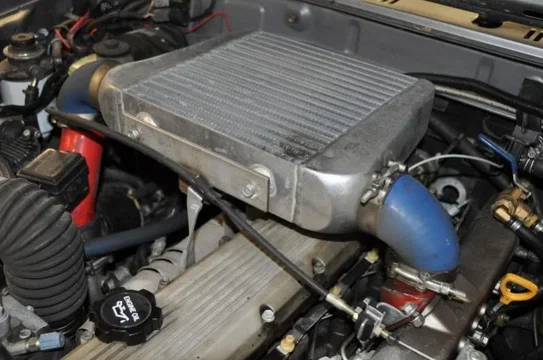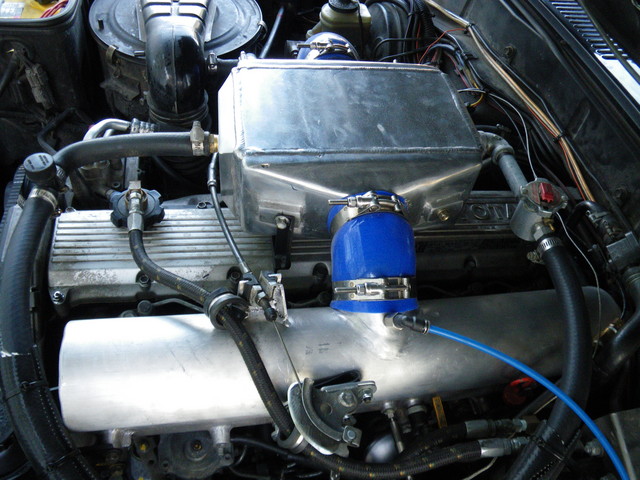Boost Max 30psi
Intercooler temps maxed out at,
Pre intercooler temp - 132 degC
Post intercooler temp - 63 degC
ETG temps - 550 degC
Thanks Bernie, can you estimate the ambient temperature for that run?
Follow along with the video below to see how to install our site as a web app on your home screen.
Note: This feature may not be available in some browsers.
This site may earn a commission from merchant affiliate
links, including eBay, Amazon, Skimlinks, and others.
Boost Max 30psi
Intercooler temps maxed out at,
Pre intercooler temp - 132 degC
Post intercooler temp - 63 degC
ETG temps - 550 degC
Thanks Bernie, can you estimate the ambient temperature for that run?




I woudnt expect a different result if you are using a 3.5 inch 12x12 core. Its actually precisely what I did except my core was 4" and I reversed the end tanks and baffled them for more even internal flow. I was disspointed in the results which is why I recomended a fearsome pusher. 68% was the best I could do which is nothing to desire. Leave room for the fan. The splitter is a good idea if you run a small scoup. My hood scoop was fully sealed to the intercooler and was 5 inches high and 20 inches wide and grabbed tons of air. Looked absolutely lame, but I wanted to see what scoup alone would do. To do it again I would use 2.5-3 inch core with a cowl induction set up and a really good fan (spal).
The fans from your link site 55mm cores which are just a little thicker than 2 inches and only could pull 250cfm? Now I can see why mounting a fan like that is a waste. Serously check out the extreme spal 11 inch fans. They pull more than twice that through 4 core radiators with an ac condenser. The two cant be compared. I think those little spal fans should be restricted weapons.
 I know I have a few people that are curious with how this all plays out, and may follow my direction if the results yield successful or turn the other way in my failure. Can't hurt but try. Either way I think it will be better than the bolt on eBay HPD copy which I am hearing guys are having a hoot with.
I know I have a few people that are curious with how this all plays out, and may follow my direction if the results yield successful or turn the other way in my failure. Can't hurt but try. Either way I think it will be better than the bolt on eBay HPD copy which I am hearing guys are having a hoot with.That NPR cooler is sweet Jereme. I really like its design.
Why not put two of them 2.5" cheapo ebay cores (12x12) one in front of the other right on top of the valve cover. That would give you the cfm you want with a thin core and double the surface area. connect them via y pipe. There not expensive and saves you from a custom end tank job. I contemplated it myself if I were to get a 1hdt. I think if you angled the front one down a bit in line with the hood it might tuck under a scoup too. I personally like the cowl look and prefere the pusher fan idea rather than a pull. And yes I know pullers are more effecient, but they are pesky to fit. I only found the need for maximum intercooling when I was WOT for long periods of time and rarely used it for day to day driving. That is where the fans are nice cus you dont use them all the time, but when you need them you get ideal air flow at the flick of a switch.
g
A bigger core won't be less effective than a smaller one, even if the gains are diminishing.
Punching CFM requirements for the 4200cc turbo diesel with the volumetric efficiency of 3 I am getting these numbers
2400 rpm - 534cfm
2600 rpm - 578cfm
2800 rpm - 623cfm
3000 rpm - 667cfm
3200 rpm - 712cfm
3400 rpm - 756cfm
I think the main advantage of going to a thicker core is it will allow a greater airflow and less pressure drop as well as providing a greater surface area for heat transfer from the air charge.
compare A 12*12*2.5 core vs 12*12*3.5 , the 3.5 will provide less resistance/greater flowor intake air.
If the 2.5 is marginal on CFM capacity, increase core size. A bigger core won't be less effective than a smaller one, even if the gains are diminishing. If the core gets heatsoaked, a larger core will take longer to shed the heat.
I guess it comes down to packaging it all.
Have you considered having the end tank on the outlet side made in sheet metal to curve down to meet the manifold plenum (similar to z()ltan's, I think he has posted pics here?), that way outlet and manifold become the new larger plenum. It may? Allow a longer core and allow you to package it close to the rocker cover.
I wouldnt totally agree with that from my expereince. A thicker core might net less pressure drop with higher IAT giving you lower egts, but if the smaller core gives you better IATs with only slightly more pressure drop it would be a better application. Trial and error comes into play here alot which sucks. That is why I recomended increasing internal volume by increasing surface area. Then you get the best of both worlds. If you want to run a 4inch core then a crazy strong fan might actually make it work properly. Its really hard to get any solid numbers in regards to pressure drop and certain cfm for these intercoolers. Bigger is better for intercoolers, bigger surface area that is, not thicker or longer core. For the overall price of these coolers, why not just mix and match them? There only like 100$ each.
How are you getting these numbers? I get way less than that, around 215cfm at 3000rpm at 100% VE for you. Id have to say that is not requiring a super high flow intercooler. You might be looking at pre turbo CFM like you did for your precleaner. Am I way off base here?
The problem with going thick 3.5-4" that that about ambient air traveling thought the core heats up as it goes. I think it was Turbonetics tested this and found that after the ambient air had traveled 3" through the core its was no longer cooling the charge air enough to justify the thicker core. Basically the air had absorbed as much heat has it could in the given time it had in the core or something like that.
I have hand tested this on a car on the dyno after a run the front of the 4" core was cold and the rear was warmer telling me that the air traveling through the last 1" or so of the core is not getting cooled as much as the front 3". This was on a front mounted setup on a petrol engine making 850whp at 28psi.
No science or math to back that up just what i read years ago on turbonetics tech bulletin and my own results.
Area vs. Thickness
Wang continues, "The rule of thumb here is obvious-bigger is better. More surface area means more cooling power. However, a larger surface area is favored over a thicker core. A larger surface area provides more cooling face for the ambient air where a thicker core might be less effective. As the core gets thicker, the ambient air traveling through the core is heated by transfer and the farther through the core it travels the hotter it gets. By the time the ambient is at the back side of the unit, it's lost a good percentage of its cooling capacity. Beyond that, thick cores cause an ambient pressure drop, which means less air will make its way to the radiator causing overheating issues.
"When it comes to area, achieving the maximum height is more beneficial than widening the unit. The main reason for this is pressure drop is greater when the charge air has to travel through longer passage compared to a shorter passage. It should be noted that pressure drop through a longer-passage core can be compensated for, to a certain extent, via fin design."
